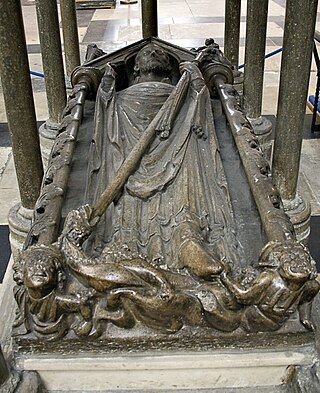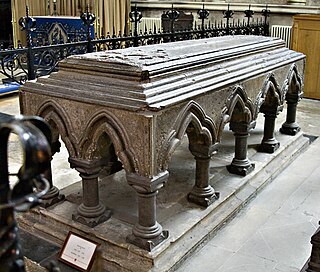Related Research Articles
Robert Winchelsey was an English Catholic theologian and Archbishop of Canterbury. He studied at the universities of Paris and Oxford, and later taught at both. Influenced by Thomas Aquinas, he was a scholastic theologian.
Thurstan or Turstin of Bayeux was a medieval Archbishop of York, the son of a priest. He served kings William II and Henry I of England before his election to the see of York in 1114. Once elected, his consecration was delayed for five years while he fought attempts by the Archbishop of Canterbury to assert primacy over York. Eventually, he was consecrated by the pope instead and allowed to return to England. While archbishop, he secured two new suffragan bishops for his province. When Henry I died, Thurstan supported Henry's nephew Stephen of Blois as king. Thurstan also defended the northern part of England from invasion by the Scots, taking a leading part in organising the English forces at the Battle of the Standard (1138). Shortly before his death, Thurstan resigned from his see and took the habit of a Cluniac monk.

Walter de Gray was an English prelate and statesman who was Archbishop of York from 1215 to 1255 and Lord Chancellor from 1205 to 1214. His uncle was John de Gray, who was a bishop and royal servant to King John of England. After securing the office of chancellor, the younger Gray was a supporter of the king throughout his struggles and was present at the signing of Magna Carta in 1215. After two unsuccessful elections to a bishopric, he became Bishop of Worcester in 1214 but soon after moved to York. During the reign of John's son, King Henry III, Gray continued to serve the king while also being active in his archdiocese. He died in 1255 and was buried at York Minster, where his tomb still survives.
Henry Wingham was a Lord Chancellor of England and Bishop of London.
Walter Giffard was Lord Chancellor of England and Archbishop of York.

Antony Bek was a bishop of Durham and the Patriarch of Jerusalem.

Sewal de Bovil was a medieval Archbishop of York.

Godfrey Ludham was Archbishop of York from 1258 to 1265.
William de Wickwane was Archbishop of York between 1279 and 1285.
Henry of Newark was a medieval Archbishop of York.
Thomas of Corbridge was Archbishop of York between 1299 and 1304.
William of St. Barbara or William of Ste Barbe was a medieval Bishop of Durham.
Walter of Kirkham was a medieval English official who held the positions of Keeper of the Wardrobe, Dean of York, and Bishop of Durham. He was elected bishop over Aymer de Valence, 2nd Earl of Pembroke, the brother of King Henry III. As bishop, he was instrumental in the founding of Balliol College in the University of Oxford.
Robert of Holy Island was a medieval Bishop of Durham.
Simon Langton was an English medieval clergyman who served as Archdeacon of Canterbury from 1227 until his death in 1248. He had previously been Archbishop-elect of York, but the election was quashed by Pope Innocent III.
William Langton was a medieval English priest and nephew of Archbishop Walter de Gray. William was selected but never consecrated as Archbishop of York and Bishop of Carlisle.
Stephen Bersted was a medieval Bishop of Chichester.

William of Louth, also known as William de Luda was a medieval Bishop of Ely.
Ralph of Maidstone was a medieval Bishop of Hereford.
Hamo was a 12th- and 13th-century English cleric. He was the Diocese of York's dean, treasurer, and precentor, as well as the archdeacon of the East Riding. His background is unknown, but he was probably a canon of the cathedral chapter at York Minster by 1171. He claimed to have been treasurer of the chapter by 1189, but did not actually hold the office until 1199. Hamo clashed with his archbishop, Geoffrey several times, and when Geoffrey died, Hamo's fellow canons were forbidden by King John of England from electing Hamo to succeed Geoffrey. Hamo died sometime after 1219, when he was last attested as holding his final office, dean.
References
- Fryde, E. B.; Greenway, D. E.; Porter, S.; Roy, I. (1996). Handbook of British Chronology (Third revised ed.). Cambridge, UK: Cambridge University Press. ISBN 0-521-56350-X.
- Greenway, Diana E. (1999). "Archbishops". Fasti Ecclesiae Anglicanae 1066–1300. Vol. 6: York. Institute of Historical Research. Archived from the original on 7 June 2007. Retrieved 22 September 2007.
- Greenway, Diana E. (1999). "Prebendaries: Warthill". Fasti Ecclesiae Anglicanae 1066–1300. Vol. 6: York. Institute of Historical Research. Archived from the original on 7 June 2007. Retrieved 22 September 2007.
- Moorman, John R. H. (1955). Church Life in England in the Thirteenth Century (Revised ed.). Cambridge, England: Cambridge University Press. OCLC 213820968.
- Prestwich, Michael (1997). Edward I. New Haven, Connecticut: Yale University Press. ISBN 0-300-07157-4.
- Smith, David M. (2004). "Romanus, John (c.1230–1296)". Oxford Dictionary of National Biography (Revised October 2007 ed.). Oxford University Press. doi:10.1093/ref:odnb/24042. Archived from the original on 17 April 2022. Retrieved 13 November 2007.(subscription or UK public library membership required)